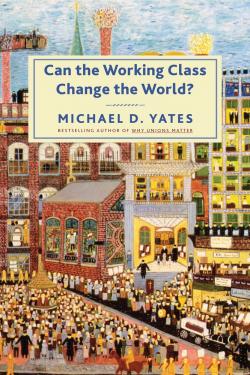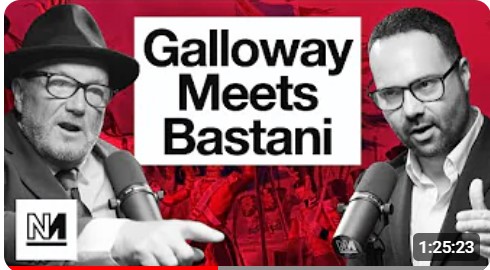By Ed Doveton
As the world burned this summer, as millions starve or go short of food around the globe, and as the quality of life for the majority of the population in the western countries tumbles and staggers, asking how we can change things for the better becomes an increasingly critical question.
In his new book, Can the Working Class Change the World?, Michael D. Yates offers readers an accessible and clear discussion on the politics of our times.
Yates is based in the USA, and, so much of his content and examples and illustrations are drawn from that country. Nevertheless, the issues, problems and struggles that are discussed have a mirrored echo in Britain and much of Europe: the details might differ, but our general experience is so often shared.
The dual premise of the book is stated early on: that while there is a growing and urgent need for fundamental and radical change, such change will not happen unless the working class and its allies, attack capitalism and its multiple oppressions head-on, on every front, all the time. “…Only this can give us hope of building a fundamentally new society, one with grassroots democracy, economic planning, a sustainable environment, meaningful work, and substantive equality in as many aspects of life as possible.”
The book begins by defining, and then dissecting and exploring, the composition of the working class world-wide. The questions looked at range from who the working class is, to commenting upon the shifting and changing composition of the working class. It considers the movement from blue-collar to white-collar and the process of de-professionalisation, where relatively privileged middle-class professions have seen the introduction of less-qualified individuals to perform the same work.
We see this in Britain, with unqualified people replacing teachers in privatised academies, and an increasing use of non-professionals in legal transactions, and unqualified individuals replacing prison wardens through private companies.
Although the definition of “working class” can include all those who work for a wage, not all occupations covered by this definition are necessarily friendly to working class interests, such as highly paid government officials, and in the United States, the police unions. As Yates says, “To include the CEO of Goldman Sachs in the working class along with farm laborers makes a mockery of the very conception of a class that could create a new world.”
Conversely, there are millions of people who are students, unemployed, or who are undertaking unpaid work in the home as carers or home-keepers. They are technically not ‘employed’ but are mostly part of the working class. If the majority of people in the world are now wage-seekers, the majority of the rest are peasants and small-farmers, who equally face problems of exploitation, manipulation of prices for their produce, and repression and land-grabs from power corporations and governments.
World working class of 3.5 billion
We are given a good tour by Yates of the statistics which back up the statements in this book, such as the estimated size of the global workforce (around 3.5 billion, out of a total population of 7.6 billion). As Yates points out, with such vast numbers of people, even a minority of these multitudes could surely change the world!
Yates’ book argues that in order to make sense of the statistics and arguments for the working class changing the world, we need a theoretical framework – something to structure our questions around, and to move on from after having worked through basic assumptions. As its starting point, the book addresses what should be obvious to us all: we live under capitalism, which is a social and political system built upon exploitation and expropriation.
The book then examines, in a very accessible way, Marx’s explanation of the source of wealth and profits under capitalism. We are reminded that neither gold, machines, nor money in the bank actually make anything. Without people they remain mere objects. It is people, who by working create our food and goods; and it is the working class that creates the wealth accumulated by the likes of Bill Gates and Warren Buffett.
There is a constant pursuit to increase profits using methods such as reducing wages, extending the working day and speeding up the rate at which people work. All these are outlined in the book, including the existence of an army of unemployed and under-employed, who, as a vulnerable group, are often willing to accept even poorer conditions of work, just to get enough to pay for food and shelter.
As we live through the chaos and crumbling structures of contemporary society, the great question unspoken on many lips is: Can it all be changed for the better? This book presents us with a four-fold answer in its final chapters. That is: (1) that it is in the interests of the working class to bring about change; (2) that the working class has previously brought about many changes for the better; (3) that such gains and positive changes are never permanent and can be reversed; and finally, (4) that the working class needs to strive to bring about whole-scale systemic change if a better future is to be secured.
In the chapter titled ‘What hath the Working Class Wrought’, we are reminded that the working class has fought for many changes that have improved the quality our lives in the West, although these have had to be wrung from the ruling elites through struggle and strife. Not least amongst these are the achievements of trade unions in improving conditions of work and wage levels.
Social gains made by socialist parties
Yates’ book uses extensive examples from the USA, which perhaps will be less known to its British audience, citing America’s history of labour unions and their past gains. There are also references to developments in Europe, where labour and socialist parties have formed governments, and where major developments in the social wage have also historically been gained with policies that were often initiated by trade unions (here in the UK, this includes the creation of the NHS and the provision of work-based pensions).
The book goes on to review that these past gains are now suffering as result of direct attacks and the process of privatisation. The last three decades have seen the rise of neo-liberalism and the establishment of the myth that the free-market mechanism was the saviour of humanity. Yates discusses this in his fifth chapter, highlighting the damage done to the old social democratic parties, who largely absorbed this alien ideology.
In Britain, we had our own experience of this process with the Labour Party under Blair, an event from which the Party is still in after-shock and is still looking for new ways to move forward and re-establish its original purpose as a socialist and labour party.
One of the weaknesses of the book is that having established the status of the old social democracy as a political expression of these struggles (although now scarred by neo-liberalism), these political parties are then largely side-lined in Yates’ final chapter. This chapter neatly considers the original question of the book’s title: Can the Working Class Radically Change the World?
Although the chapter highlights that in order to achieve change we need to think of ‘multiple terrains of struggle’, consideration of the role that specific political parties can play is missing from Yates’ broader analysis. Working class political representation is discussed largely through the perspectives and politics of the United States, which does not have a significant political party of this type. Nevertheless, the chapter remains a good summary, drawing together the strands of the other chapters to offer the reader a perspective for struggle and change.
Michael D. Yates has provided an insightful survey of the meaning behind the problems that we all face under capitalism. His book suggests ways in which the world can be changed for the better. And it does so in an extremely readable way, with easily accessible language. Themes, that in other treatises fall into a swamp of convoluted language, are presented in this text in a straightforward and lucid manner. If the UK publication date in August is too late for your summer reading, do consider purchasing the book as the inspirational basis for your own political activities over the coming year.
August 1, 2018
Can the Working Class Change the World? Michael D. Yates, Published Monthly Review Press, September, 2018 £16.99



